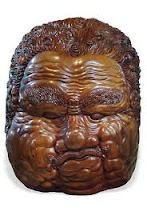Borobudur is the name of a Buddhist temple located at Borobudur, Magelang, Central Java, Indonesia. Location of the temple is about 100 km southwest of Semarang and 40 km northwest of Yogyakarta. Stupa shaped temple was founded by the Mahayana Buddhists around AD 800-AD in the reign of an dynasty dynasty. The monument comprises six square terraces Yeng above there are three circular courtyard, the walls adorned with original 2672 relief panels and 504 Buddha statues there
The main stupa in the middle of the largest teletak once crowned this building, surrounded by three rows of round 72 perforated stupas in which there are statues of Buddha sitting cross-legged in the lotus position perfectly with the mudra (hand position) Dharmachakra mudra (turning the wheel of dharma).
This monument is a model of the universe and built as a shrine to honor the Buddha also functions as a place of pilgrimage to guide mankind to switch from natural lust to enlightenment and wisdom according to the teachings of Buddha.
The pilgrims enter through the east side starting at the base of the temple ritual walk around holy building is in a clockwise direction, while continuing to go up to the next steps in the sphere through three levels of Buddhist cosmology. The third level is the K? Madh? Tu (the realm of the passions), Rupadhatu (sphere shape), and Arupadhatu (the realm of intangibles). In this way of pilgrims walking through the hallway and staircase with a series of witnessed no less than 1460 beautifully carved relief panels on the wall and balustrade.
According to historical evidence, Borobudur abandoned in the 14th century as the weakening of the influence of Hindu and Buddhist kingdoms in Java as well as from the influence of Islam. The world began to recognize the existence of this building since 1814 was found by Sir Thomas Stamford Raffles, who was then serving as Governor General of British control over Java. Since then Borobudur has suffered a series of rescue and restoration efforts. Largest restoration project was held in the period 1975 to 1982 the efforts of the Government of the Republic of Indonesia and UNESCO, and historic sites are included in the list of World Heritage Sites.
Borobudur is still used as a place of religious pilgrimage; each year Buddhists who come from all over Indonesia and abroad gather at Borobudur to commemorate Vesak Trisuci. In the world of tourism, tourism Borobudur is Indonesia's single most visited by tourists.
Relief
On the temple walls at every level - except on the terraces Arupadhatu - carved panels of bas-reliefs that will always remind the history of Borobudur temple which is made with great accuracy and fine. [54] Relief and decorative patterns Borobudur naturalist style with ideal proportions and refined aesthetic taste. These reliefs are very beautiful, even regarded as the most elegant and graceful in the world of Buddhist art.
Borobudur reliefs of Indian art discipline as well as a variety of posture has a specific meaning or aesthetic value. Reliefs noble human form as a hermit, king and noble women, angel atapun creature like a god to achieve the degree of purity, such as tare and boddhisatwa, often depicted with the body position tribhanga. These postures are called "three curves" that is curved or bent slightly at the neck, hips, and ankles with only the body weight resting on one leg, while the other leg resting dilekuk. A flexible body position implies elegance, such as a standing figure of an angel with an attitude Surasundari tribhanga body clutching long-stemmed lotus.
Borobudur reliefs showing many images, such as human figures both nobles, commoners, or a hermit, a variety of plants and animals, as well as displays of traditional vernacular building form the archipelago. Borobudur is like a book like that record various aspects of ancient Javanese society. Many archaeologists researching past life in ancient Java and the archipelago centuries-8-9 and to look at and refer to the carved reliefs of Borobudur. The stage-house, barn, palaces and temples, the form of jewelry, clothing and weaponry, various plants and wildlife, as well as a means of transportation, it was noted by the researchers. One of them is a relief depicting the famous Borobudur Ship. Typical timber ship bercadik archipelago shows ancient maritime culture. Ark replica of Borobudur reliefs made by Ocean Mercury is stored in the Museum, located on the north Borobudur.
Buddha statue
In addition to the buddha in the form of Buddhist cosmology carved in the wall, there are many statues at Borobudur Buddha sitting cross-legged in the lotus position and displays the mudra, or symbolic hand a certain attitude. Buddha statue with a height of 1.5 meters was carved out of andesite rock materials.
 08.40
08.40
 Original Indonesia
Original Indonesia

0 komentar:
Posting Komentar